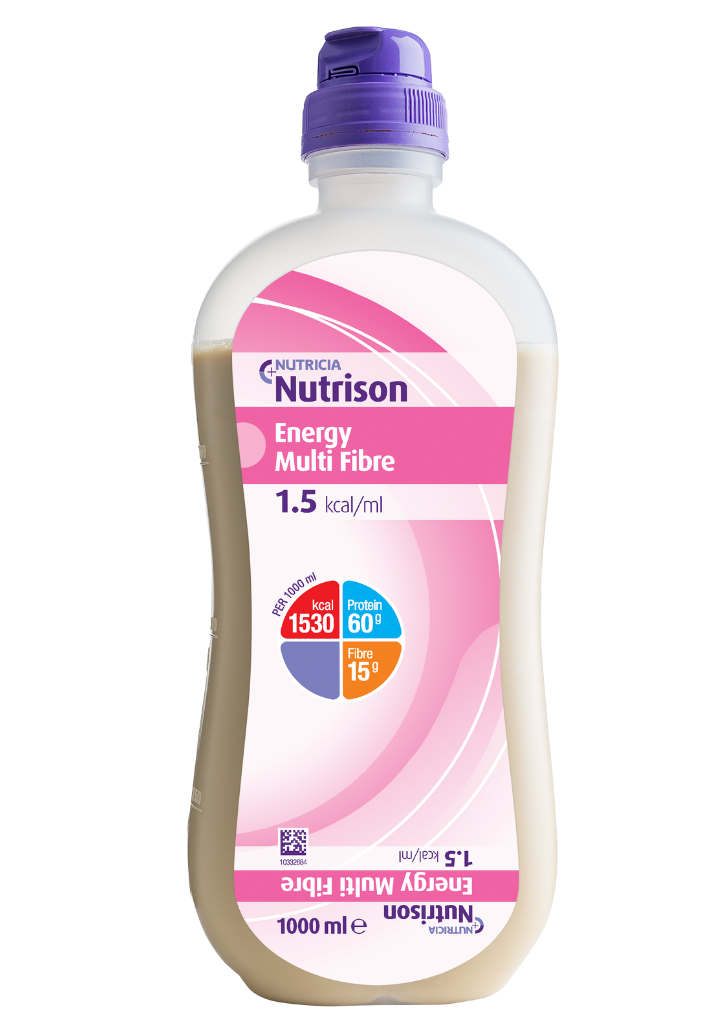
Product Information
A nutritionally complete, high energy, fibre enriched, ready-to-use enteral tube feed.
Link copied!
Indications
For use in the dietary management of:
- Disease-related malnutrition.
- Patients with high energy and protein requirements.
Important Notice
- Not for parenteral use.
- Not suitable for patients requiring a fibre free diet.
- Not suitable for patients with galactosaemia.
- Not suitable for patients with cow’s milk protein allergy.
- Not suitable for infants under 1 year of age.
- Use with caution in children aged 1-6 years of age.
- Use with caution in individuals with a seafood allergy.
- Must be used under medical supervision.
Directions for Use
- Check appearance before use and shake well.
- Do not dilute or add medications to the formula.
- Use at room temperature.
- Handle aseptically to ensure product remains sterile.
- Usage to be determined by a healthcare professional.
Storage
- Store in a cool, dry place.
- Once opened, close the bottle and store in a refrigerator.
- Discard unused content after 24 hours.
Order Information
Contact Nutricia Customer Experience 0800 688 747
| Nutrison Energy Multi Fibre | Product Code | Units per carton | Pharmacode |
| 1000ml OpTri bottle | 132196 | 8 | 2702452 |
Ingredients
Full ingredients list and nutritional information is available on the product fact sheet.
Allergen & Cultural Information
- Contains: milk, soy and fish.
- Halal certified.
- Nutricia UK and/or Ireland have Kosher approval for this product.
- No gluten containing ingredients. No detectable gluten when tested to a sensitivity level of less than 5 parts per million (<5 ppm i.e. <5mg/kg).
- Low lactose (lactose <2g/100g).
References
- World Health Organization. Protein and amino acid requirements in human nutrition: report of a joint FAO/WHO/UNU expert consultation. 2007; WHO technical report series ; no. 935.
- Kuyumcu S, Menne D, Curcic J, et al. Noncoagulating enteral formula can empty faster from the stomach: A double-blind, randomized crossover trial using magnetic resonance imaging. Journal of Parenteral and Enteral Nutrition. 2015;39:544-551.
- van den Braak CC, Klebach M, Abrahamse E, et al. A novel protein mixture containing vegetable proteins renders enteral nutrition products non-coagulating after in vitro gastric digestion. Clinical Nutrition. 2013;32:765-771.
- Klebach M, Hofman Z, Bluemel S, et al. Effect of protein type in enteral nutrition formulas on coagulation in the stomach in vivo: Post hoc analyses of a randomized controlled trial with MRI. Abstract presented at Clinical Nutrition Week, January 16–19; Austin, Tx. Journal of Parenteral and Enteral Nutrition. 2016;40:134(21).
- Luttikhold J, van Norren K, Rijna H, et al. Jejunal feeding is followed by a greater rise in plasma cholecystokinin, peptide YY, glucagon-like peptide 1, and glucagon-like peptide 2 concentrations compared with gastric feeding in vivo in humans: a randomized trial. Am J Clin Nutr. 2016;103:435–43.
- Abrahamse E, van der Lee S, van den Braak S, et al. Gastric non-coagulation of enteral tube feed yields faster gastric emptying of protein in a dynamic in vitro model. Abstract presented at 34th ESPEN Congress. Sept 8-11; Barcelona, Spain. Clinical Nutrition Supplements. 2012;7:PP239(119).
- Liu J, Klebach M, Abrahamse E, et al. Specific protein mixture reduces coagulation: An in vitro stomach model study mimicking a gastric condition in critically ill patients. Poster presented at 38th ESPEN Congress. 17-20 September; Copenhagen, Denmark. Clinical Nutrition. 2016;35:MON-P182 (S220).
- Beckers EJ, Jeukendrup AE et al. Gastric emptying of carbohydrate–medium chain triglyceride suspensions at rest. Int J Sports Med. 1992 Nov;13(8):581-4.
- Hunt JN, Knox MT. A relation between the chain length of fatty acids and the slowing of gastric emptying. J Physiol. 1968 Feb;194(2):327-36.
- Cooper DA, Eldridge AL, Peters JC. Dietary carotenoids and certain cancers, heart disease and age-related macular degeneration: A review of recent research. Nutrition Reviews 1999;57: 201-214.
Additional Information
^ In accordance with Australia New Zealand Food Standards Code – Standard 2.9.5
# MF6 is a unique, patented blend of six soluble and insoluble fibres (soy polysaccharide, cellulose, resistant starch, gum arabic, oligofructose and inulin) reflecting the proportions of the different fibre types in a healthy diet.
